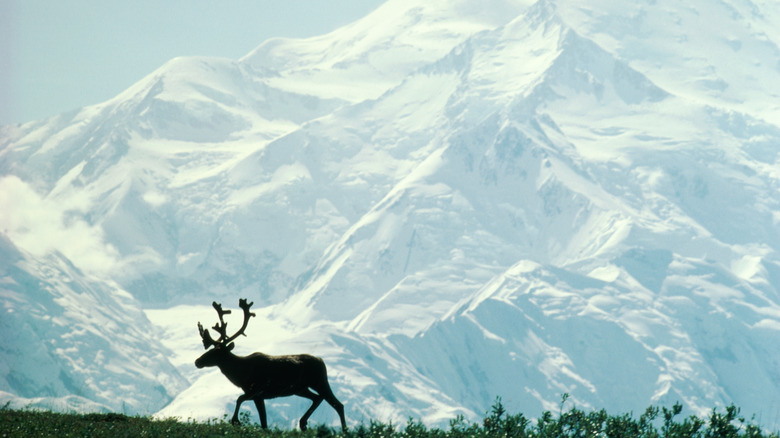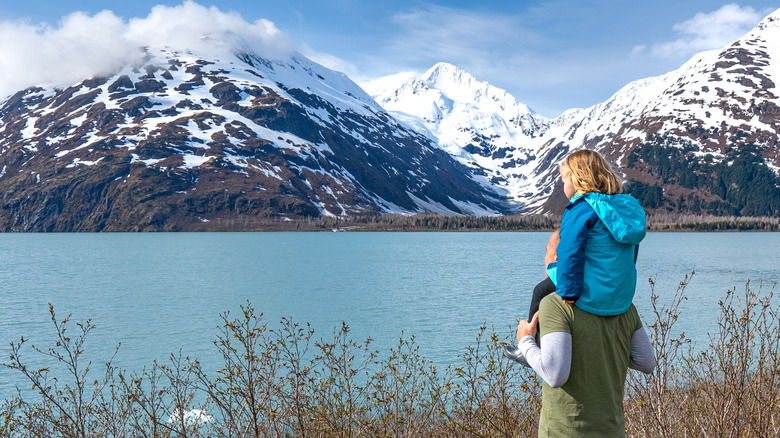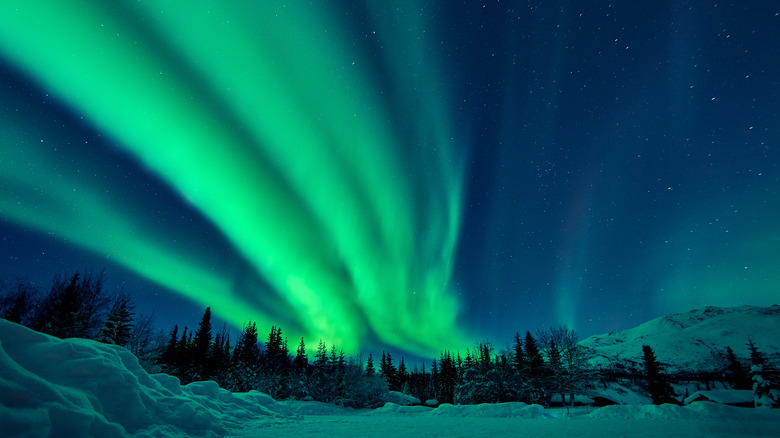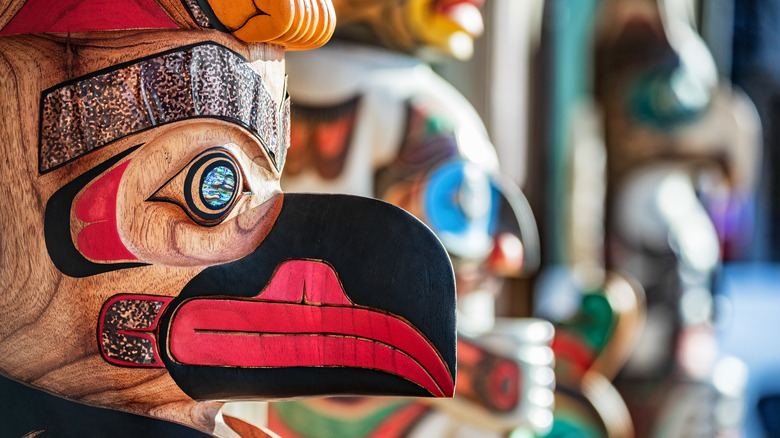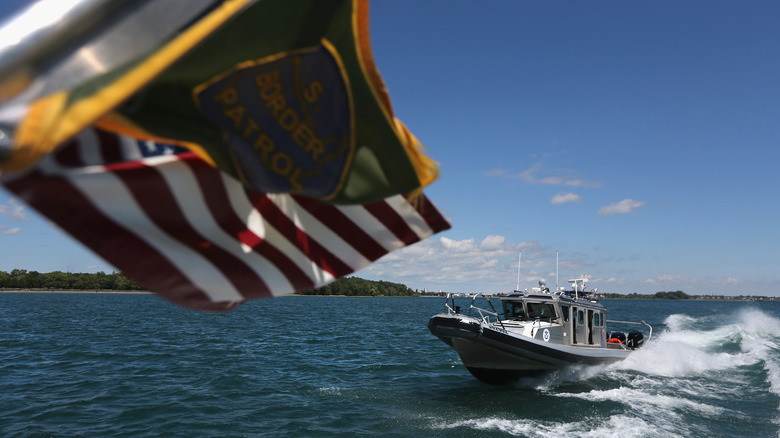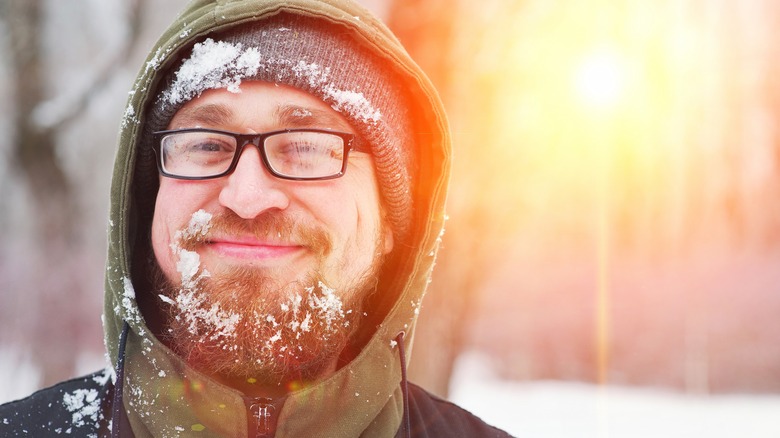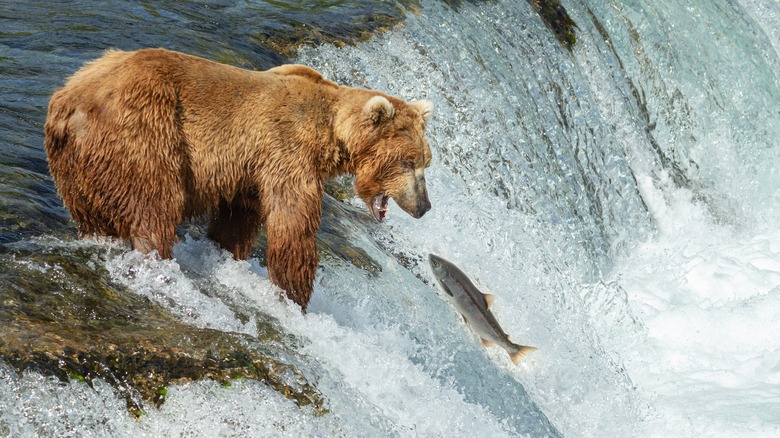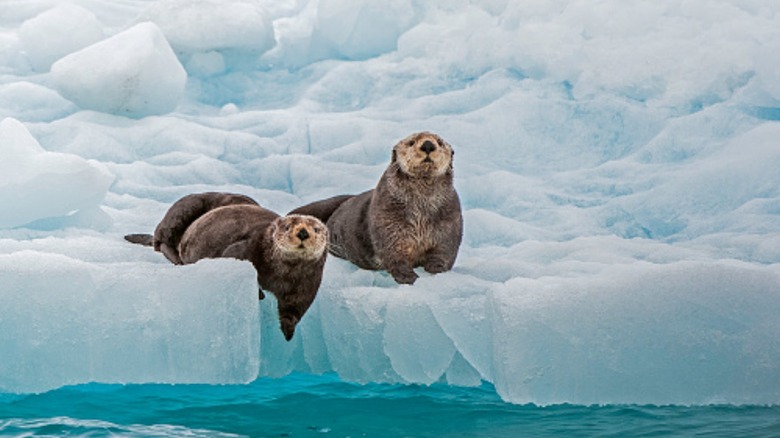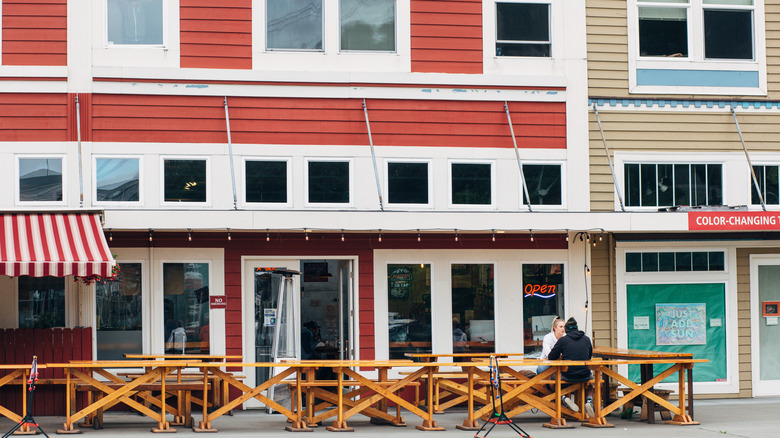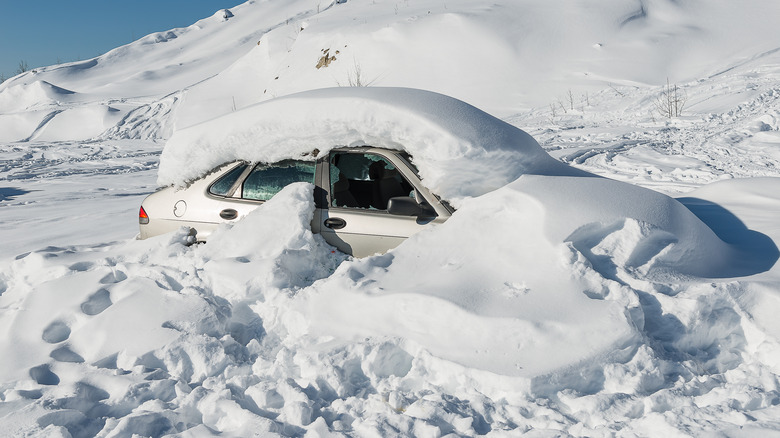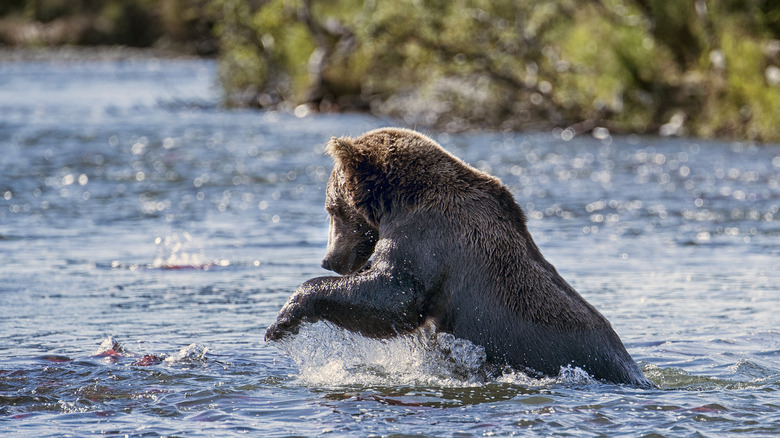11 Things Tourists Should Never Do When Visiting Alaska
Alaska continues to fascinate visitors from around the world. Not quite as rugged as visiting the Arctic, Alaska is still wildly wild. For instance, this mountainous state houses 17 of the 20 highest peaks in the U.S. Unbridled wilderness can make traversing the land difficult if you don't know the area well, making Alaskan travel plans more detail-oriented than other itineraries.
Despite the often cold temperatures and, at times, tumultuous terrain, Alaskan tourism remains a considerable part of the state's economy. In fact, per the Resource Development Council, one in 10 jobs in Alaska is in the tourism industry. Plus, one in three travelers to Alaska is a return visitor, so something about the place leaves a big impression on those who see it. Whether it's the almost unparalleled wildlife, the people, or the nonstop access to fresh seafood, Alaska has a way of making visitors fall in love with it.
While many visit The Last Frontier for the adventure, there are also many cultural touchstones. Because these realities co-exist, there are a handful of things visitors (especially first-timers) need to know about Alaska, especially when it comes to what to avoid. Not only are these tips helpful for travel planning, but they'll also make you a responsible tourist in a new place.
Ignore the notion of leave no trace
Alaska is a beloved travel destination in part because of its absolute wilderness. However, that majestic natural beauty can't be maintained if visitors don't follow the protocols of "leave no trace." That means leaving things as they are, not taking things with you from nature, and not leaving trash or damaging the natural environment. Yes, that means not taking plants, shells, or anything else you find outside.
This idea of "leave no trace" also applies to more practical parts of being a traveler. For example, if you've ever been hiking and see signs to stay on the trail to protect the ecosystem, that's part of this notion. When trails are established, they do so in a way that will do the least harm to their environment. So, if hikers roam wherever they want off-trail, they could be crushing vital native plant life or disturbing important nesting locations.
It is also essential for campers to pack up everything they bring with them to camp. Bring an extra bag to dispose of garbage properly away from the campsites. Litter can be dangerous or even deadly to wildlife. The Alberta Institute for Wildlife Conservation noted that two of the most common injuries it treats are litter-related. Animals are hit by cars (because they're busy investigating the litter), or they get trapped in the litter. Either way, these situations are easily avoided by correctly disposing of garbage.
Assume you can see it all
Many first-time visitors to Alaska may think they can dash over to Denali from Juneau during a quick trip. Contrary to what maps would have you believe, Alaska is enormous. That trek from Juneau to Denali? It'll take up to 20 hours by car, including the ferries. Sure, it's doable, but you need to understand the mechanics of the trip before taking it.
The three largest cities in the state are Anchorage, Fairbanks, and Juneau. So if you're in doubt about where to visit, start with one of them. You can decide on an area of Alaska you would like to see rather than hoping you can squeeze multiple regions into a week. Not only will that involve a ton of commuting and far less adventuring, but it will also be expensive traversing the state.
There are five regions in Alaska to choose from. For reference, Anchorage is in the Southcentral region, Juneau is in the Southeast, and Fairbanks is in the Interior. If you've never been to Alaska before, consider starting with Anchorage. As the largest city in the state, Anchorage has so much to do. It's also a terrific jumping-off point for different day trips if you want to get out and see more of nature, like the Portage Glacier.
Disengage with native culture
In Alaska, there are 228 federally recognized tribes of Alaska Natives or indigenous peoples. Statistically, about 19% of the total population of Alaska comprises native people, so there is a lot for visitors to learn about those tribes. Engage in the culture and return home with a greater understanding of Alaskans. If you disengage from such a vast part of the populace, you're missing out on many opportunities to learn and see the state.
Brendan Sainsbury at Lonely Planet suggested visiting the Anchorage Museum or the Alaska State Museum to learn more about Alaska Natives. Both of those museums are in Juneau, the capital city of Alaska. He also noted to keep an eye out for totem poles to glean further insight into the lives of Alaska Natives.
"Viewing totem poles will also give you some insights into the Native culture of Alaska. Emblematic of the people of the southeast coast and British Columbia, these zoomorphic sculptures are loaded with cultural, historical and artistic significance," Sainsbury stated. "You'll find an abundance of totem poles in the southeastern panhandle, particularly in Ketchikan's Saxman Village and Totem Heritage Center, and Sitka's National Historical Park."
Forget that Alaska is part of the U.S.
This one may sound silly to some, but it's not uncommon for tourists to assert that Alaska is a foreign land. It may be far removed from your home state, yet Alaska is still very much a part of the U.S. That's just one of many misconceptions about Alaska. A woman even went viral on TikTok in 2023 because she thought the state was an island like Hawaii due to how it is shown on maps. It is not, in fact, an island, although it is frequently depicted as one on maps of the United States.
Don't go to Alaska and try to exchange your U.S. currency, ask people if they speak English, or in any way assume that the state is unlike the rest of the country. Don't make folks you encounter feel that they're being othered. And, no, Alaskan businesses don't accept loonies, toonies, or any form of Canadian currency. They may geologically be separated from the lower 48 states by Canada, but they still use the United States Dollar.
Underprepare for the weather
Alaska is one of those places where the weather can change at the drop of a hat. The last thing you'll want is to be miles away from a shelter, stuck waiting out a rainstorm, or cut short outdoor activities because you didn't pack enough warm clothes. The best thing you can do is know what typical seasonal weather is for when you're going and packing around that. Remember that you can always wear or bring your coat or bulky sweater on the plane instead of shoving it into your over-full suitcase.
Valerie at Valerie & Valise, who grew up in Alaska, has a handy summary for seasonal weather. Summer has warmer temps; fall is still sunny with the potential for snow; winter offers the Aurora Borealis, and the shortest month of spring shows melting snow with increasing warmth. She also noted that the summer months are the most popular for travelers in Alaska, while winter comes in at a close second.
Because the summer warm-up also brings rain, Valerie advised to be prepared for rainy weather. "My family joked growing up that the weather changes every five minutes in Alaska," she wrote. "So plan ahead: pack for rain. The worst thing that happens is that it sits in your suitcase for the whole trip!" Even something as simple as a portable poncho could save the day when in doubt. You don't have to pack a whole rainy-day ensemble; some fail safes will do.
Underestimate wildlife
Most travelers know that they need to keep an eye out for bears when hiking in Alaska's parks. But they might not realize that they may encounter myriad other animals that pose a threat, no matter how cute they are. Underestimating the danger of any wild animal, especially in Alaska, could put you in harm's way. Those dangers don't stop at big mammals either; there are 35 species of mosquitos in Alaska, believe it or not.
Nearly 30% of recorded bear attacks in the United States have occurred in Alaska. That statistic isn't meant to scare you, just to emphasize how disproportionately large the bear population is in The Last Frontier. Although they are friend-shaped, it's always best to keep a fair distance between you and any wildlife – particularly during the various breeding seasons. For the record, brown and grizzly bear mating season is from May to July.
The National Park Service suggests a few ways to keep yourself and the wildlife safe during your time in nature. NPS says to stay at least 300 yards away from bears and 25 yards from everything else, including dens or nests. It also advises never to feed wildlife, even if they seem non-threatening, like a chipmunk or squirrel, because they can become food aggressive. Alaska has incredible wildlife that can be viewed safely. As always, be aware of your surroundings.
Book at the last minute
Travel writers often advise against making the booking mistake of purchasing a trip too early – that isn't the case with Alaska. As a destination, Alaska is one of the places where you need to book well in advance or risk your hotel, activities, car rental, etc., options being limited. How far in advance you need to book depends on the trip you're planning, though. For example, you may want to book Alaskan cruises at least a year in advance, particularly if you want to save money on the trip.
In general, book at least four to six months in advance unless you're going in a big group, in which case a minimum of six months is recommended. If you plan on visiting during the busiest season (the summer), book hotels and tours as soon as possible. That said, you will have a bit more wiggle room if you're going to Alaska in the shoulder seasons of spring and fall. Not to mention that traveling during shoulder season is often much cheaper than going during peak tourist season.
Skimp on tipping
It's never a good look to pinch pennies when tipping out at a restaurant or for a tour guide. That's doubly bad in a place like Alaska, where the cost of living can be sky-high. Its remoteness heavily impacts the price of everything from groceries to gas and everything in between. So, when planning an Alaskan trip, try to accommodate tipping at least 20%. Don't forget to tip your tour guides, luggage helpers, baristas, and bartenders, too.
The average cost of living in Alaska, across the board, is 30% higher than in the rest of the United States. The most inflated costs are monthly utilities at 46%, food at 40%, and healthcare at 49%, higher than the national average. Knowing that you might want to tip more generously than you may during your daily life. It's also worth knowing the higher costs anyway, as you could see those costs reflected during your trip. Whether you go grocery shopping or eat out at restaurants, the cost of goods might be higher than you're used to.
Especially as we deal with the dreaded tip fatigue, because so many less traditional places are now requesting tips, remembering to tip for good service can be cumbersome. Only about 80% of Americans always tip their waitstaff, according to 2023 data shared by the Pew Research Center. Don't let tipping fatigue get in the way of thanking someone for their hard work!
Hit the road without a plan
As previously mentioned, Alaska is enormous. When you set out on an Alaskan road trip, you'll notice pretty quickly that there aren't a lot of areas to stop off at. Whether that's for getting gas or going to the bathroom, you'll need to be strategic about where you stop and how often you do so. Adam at Getting Stamped recommended driving in Alaska from May to September when there is more daylight and warmer road conditions. Driving in wintery Alaskan conditions can be tricky.
If you don't mind the sometimes treacherous weather Alaskan winter can bring, Adam had a few suggestions for how to venture safely. "If you are up for this adventure, ensure you are prepared and have a backup plan!" He wrote. "Always have extra gas with you. Gas stations along the Alaska Highway have very limited hours in the winter. Expect extreme cold temperatures. Make sure you have the appropriate cold-weather clothing and gear in your car." Driving can be a massive bonus to seeing as much Alaska as possible during a vacation. You must be aware of the road conditions and pack and plan accordingly.
Presume everywhere can cater to dietary needs
This is not to say that restaurants and hotels aren't looking out for your best interest. This is another tip related to the remoteness of Alaska. Because fresh veggies or fruit can be harder to come by, folks like vegetarians may have a harder time finding dietary accommodations. If you're planning a trip and you have vegetarian or vegan restrictions, or any dietary needs for that matter, consider that if you are going to more rural parts of Alaska. Accommodating special diets will be even more complicated outside of major metropolitan areas.
When traveling with a tour group, especially if they are planning meals, be sure to inform them well in advance about any dietary restrictions. That includes allergies; they need to know how to keep everyone safe and fed. As a precaution, pack some easy-to-go snacks that fit your dietary needs. That way, you are still well-fed between meals and prepared if given some food options that won't work. After all, it's possible that a tour or group trip can't always accommodate dietary restrictions depending on where you are. Also, try to bring goods that don't require refrigeration or preparation to make your life easier.
Not following hunting and fishing protocols
Many Alaskans hunt for sustenance, with the fish or game they catch feeding themselves and their families. While many trophy hunters visit Alaska yearly, it's important to recognize the need for protocols to stop overhunting or overfishing – and stick to them. According to the Alaska Professional Hunters Association (APHA), non-Alaskans who want to hunt in the state may require a guide. Per the site, anyone who wants to hunt mountain goats, Dall sheep, or brown-slash-grizzly bears must have a guide with them. While it isn't required outside of those target parameters, the APHA also notes that a lot of game hunters who visit Alaska still choose to bring a guide anyway for their help.
It's also important to recognize that in parts of Alaska, whale hunting is not only legal but necessary for use in select communities for food and other byproduct uses. The Indigenous Inupiat and Siberian Yupik communities hunt whales under the very stringent regulations of the International Convention for the Regulation of Whaling. It is illegal for whale meat to be sold outside of the Alaska Native communities, too, so do not purchase it if you happen to see someone selling it.
